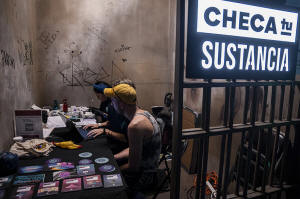Facts, not fear: Inside Mexico's pioneering drug harm reduction programs
[March 17, 2025]
By CATERINA MORBIATO
MEXICO CITY (AP) — Under warm strobe lights and pulsing house beats, a
recent festival in Mexico City offered more than music, food and booze.
Amidst the usual festival fare, a booth provided free, anonymous drug
testing.
The initiative, known as “Checa tu Sustancia” (Check Your Substance), is
one of several recent efforts by Mexican civil society to reduce risk
among people taking drugs. Spearheaded by the Instituto RIA, a
Mexico-based drug policy research and advocacy organization, it aims to
address drug use from a public health and social justice perspective,
rather than a security one.
In a well-lit corner of the festival, members of the Instituto RIA used
reagents and laboratory porcelain plates to test substances that some of
the partygoers planned to use and recorded the data. Their analysis uses
color changes to indicate what’s in the drug: It can reveal the presence
of adulterants but not their exact proportion.
They also offered test strips that can detect the presence of fentanyl
and nasal sprays of naloxone, a medication designed to rapidly reverse
opioid overdose.
Also available were informational flyers detailing the effects of
various psychoactive substances and what to do to reduce the risks
associated with using them, including simple but critical measures like
staying hydrated and eating well.
While some partygoers seemed wary of the initiative, others approached
it with curiosity.
“(There is) amazement, but also a little bit of fear, because there is a
whole context of criminalization,” said social psychology student
Jessica Reyes Moreno, 27, a volunteer with Checa tu Sustancia.
When unexpected substances are detected, users receive detailed
information on what they are, about their risks, potential interactions
with other substances and dosage adjustments, empowering them to make
informed choices.

Harm reduction vs. abstinence
When people understand that the focus is not on prohibiting but on
offering information and safe, non-judgmental spaces where they can be
heard, trust is built, said Reyes Moreno.
"I think it’s information we should have. Because (drug use) is taboo,
and if we're uninformed, we can overdose,” said a 34-year-old Mexican
partygoer, who requested anonymity due to his use of illicit substances.
He said he feels there isn't enough information about illegal drugs in
Mexico, and when there is, it's either confusing or all stigma. "It’s
just ‘Don’t do it,’ but there’s no such thing as ‘If you do it, take
this precaution.’”
The “don’t do it” approach sees abstinence as the solution. In contrast,
harm reduction, as defined by Harm Reduction International, aims to
minimize the negative health, social and legal effects of substance use
by working with people without judgment or requiring them to stop using
drugs.
The approach focuses more on people — and their communities— than on the
substance.
“We never say, ‘you shouldn’t consume this,’” said Zara Snapp, a
political scientist and director of the Instituto RIA. “The best way to
reduce your risks is not to consume at all. But if you have made the
decision to consume, we want you to have as much information as possible
so you can take care of yourself.”
‘Choose to be happy’
The prohibitionist, hardline approach of the war on drugs in Mexico has
led to the perception of the user as someone who is necessarily
associated with drug trafficking or criminal activities.

[to top of second column]
|

A man waits for his drug's lab results at the Check Your Substance
booth that offers free drug testing, where people can confirm their
drug does not contain adulterants or fentanyl, at a three-day
electronic music festival in Mexico City, late Friday, Jan. 30,
2025. (AP Photo/Aurea Del Rosario)
 Earlier this year, Mexico President
Claudia Sheinbaum unveiled her government’s latest anti-drug
campaign, “Stay away from drugs. Fentanyl kills,” which centers on
the synthetic opioid responsible in its deadliest year for more than
70,000 overdose deaths each year in the U.S. — now down to an
estimated 52,000 deaths a year.
Aimed at young Mexicans, the campaign frames drug use as a public
health issue, but some of the videos and glowing neon billboards
show scenarios in which death and loneliness (drug use) are
contrasted with life and family (not using drugs). They read,
“Choose to be happy.”
“It’s not that if I use drugs I won’t be happy, or if I stop using
drugs I’ll be happy,” said Lilia Pacheco, operational director of
PrevenCasa A.C., a Tijuana-based organization that runs
harm-reduction initiatives for opioid users, mostly deportees from
the United States who report that they started using in that
country.
“How can we say that to someone who is using because they are cold,
hungry or in withdrawal?” she said.
Mexico's health department did not immediately respond to inquiries
regarding concerns that its latest campaign stigmatizes drug use.
Dr. Carlos Magis, a professor at Mexico’s National Autonomous
University’s medical school and member of a working group on
opioids, said that stigma poses serious challenges. He cited
examples of health workers refusing treatment without abstinence,
limited access to naloxone or the scarcity of public methadone
clinics.
Breaking down fear and social isolation
A recent report by the Mexican Observatory of Mental Health and Drug
Use, found that between 2013 and 2024, 5,901 people in Mexico were
treated for emergencies related to opioid use, with it trending up.
PrevenCasa reduces harm not by asking users to stop using, but by
showing that their lives matter by providing them with safe
injection equipment, showers, toiletries and social events like
Friday movie nights.
“These interventions improve quality of life, unlike a sign that
says ‘fentanyl kills you,’" said Pacheco. “The right to health
should be universal.”
Both Pacheco and Snapp emphasized that collective care is at the
heart of harm reduction efforts. Whether practiced in the facilities
of organizations working on the border or at electronic music
festivals, the goal is to break down social isolation and fear in
concrete ways.

“This is a service that will save lives...it’s very
forward-thinking,” said a 43-year-old man, who requested anonymity
because he is a user of illicit substances, after members of
Instituto RIA tested his ecstasy at a recent festival.
He said that drug testing kits are available in the United States,
where he’s from, but that in his experience so far, it’s something
people mostly do on their own or behind closed doors.
The visibility and organization of Checa tu Sustancia was a surprise
to him.
“I feel good that I’m not doing anything wrong. I’m just here to
have fun, but now with peace of mind,” he said with a smile. He then
rejoined his friends and disappeared into the dancing crowd.
All contents © copyright 2025 Associated Press. All rights reserved |